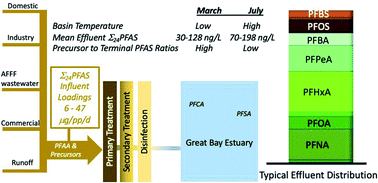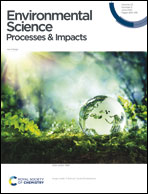Distribution and fate of per- and polyfluoroalkyl substances (PFAS) in wastewater treatment facilities†
Abstract
Anthropogenic compounds known as per- and polyfluoroalkyl substances (PFAS) represent a major class of contaminants of emerging concern composed of nearly 5000 chemicals. Many PFAS are persistent, bioaccumulative and toxic, and their widespread use makes their environmental distribution a growing concern. Wastewater treatment facilities (WWTFs) are a conduit of PFAS to the environment, integrating common household products from municipal sewage, industrial wastewater sources, septic materials, and firefighting wastewaters in effluent and sludge. This study investigated the distribution and fate of twenty-four PFAS within six New Hampshire municipal WWTFs applying a range of biological and disinfection unit processes. PFAS quantification was conducted using two approaches: (1) liquid chromatography with tandem mass spectrometry (LC-MS/MS) of 24 known compounds and (2) a total oxidizable precursor assay (TOP assay) followed by LC-MS/MS to determine the total oxidizable PFAS concentration. Of the 24 PFAS analyzed, up to 7 and 12 constituents were detected in influent and effluent of WWTFs, respectively, with concentrations ranging from 30 to 128 ng L−1 in March. Effluent ΣPFAS concentration increased during July, with concentrations between 70 and 198 ng L−1 for the same detected constituents. Short-chain PFAS were dominant in both influent and effluent, while long-chain compounds dominated in WWTF sludge. The increase in terminal end-products after oxidation by the TOP assay indicates the presence of unquantified PFAS precursors in both influent and effluent. A significantly lower proportion of oxidizable PFAS precursors were detected in July influent and effluent relative to March, indicating a possible role of season or temperature on microbial transformation of these compounds prior to reaching WWTFs and during treatment. These results provide new insight into PFAS distribution and fate during two seasons in New England municipal WWTFs.

- This article is part of the themed collections: PFAS: cleaning up drinking water, World Earth Day and Best Papers 2021 - Environmental Science: Processes & Impacts


 Please wait while we load your content...
Please wait while we load your content...